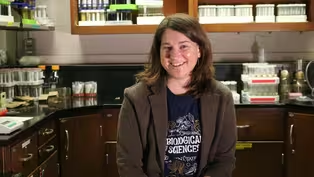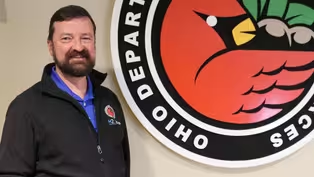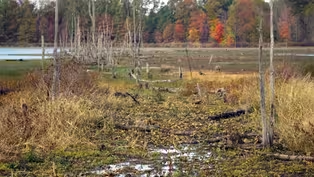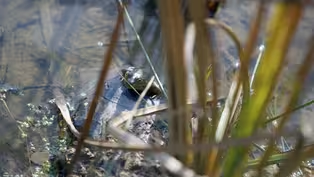
Welcome to the Wetlands
4/22/2025 | 26m 53sVideo has Closed Captions
Explore the threats facing Ohio’s wetlands and the fight for their future.
Discover an ecosystem under threat and the people and forces working to save it — the fascinating world of the wetlands. Exploring Ohio’s diminished wetlands, this episode examines the dangers wetlands are facing and what can be done to preserve them with the help of local experts.
Problems playing video? | Closed Captioning Feedback
Problems playing video? | Closed Captioning Feedback
By Nature’s Design: Exploring Our Native Wildlife is a local public television program presented by PBS Western Reserve

Welcome to the Wetlands
4/22/2025 | 26m 53sVideo has Closed Captions
Discover an ecosystem under threat and the people and forces working to save it — the fascinating world of the wetlands. Exploring Ohio’s diminished wetlands, this episode examines the dangers wetlands are facing and what can be done to preserve them with the help of local experts.
Problems playing video? | Closed Captioning Feedback
How to Watch By Nature’s Design: Exploring Our Native Wildlife
By Nature’s Design: Exploring Our Native Wildlife is available to stream on pbs.org and the free PBS App, available on iPhone, Apple TV, Android TV, Android smartphones, Amazon Fire TV, Amazon Fire Tablet, Roku, Samsung Smart TV, and Vizio.
Providing Support for PBS.org
Learn Moreabout PBS online sponsorship(soft music) - [Narrator] Nature's kidneys.
This humble ecosystem filters water, provides habitat for wildlife, and improves our water quality.
With the risk of losing what is left, people are turning their attention to this wildlife wonder, the wetlands.
This is "By Nature's Design".
Welcome to the Wetlands.
- A wetland is really an area that is not always wet.
We're not talking about deep water.
And it's certainly not dry land, either.
It's something kind of in between.
And a wetland doesn't always have to be wet.
Wetlands are sometimes wet in the spring and not later in the year.
And it's an area, from my perspective, where water just kinda slows down on the landscape for a little while on its way between upland and our streams, rivers, and lakes.
Wetlands are a really important part of our landscape in Ohio, and they're actually an important missing part of a lot of our landscape in Ohio.
We used to have a lot more wetland acreage in Ohio than we do now.
In fact, more than 90% of the wetlands that were once here are gone.
So very important to protect and preserve what we have left.
- Wetlands are important to Ohio ecosystems for a number of reasons.
The first, and perhaps the most important from many people's point of view, is flood control.
Being a low point, if you have a wetland there, it is going to collect the water instead of it flooding into people's basements, across roads, et cetera.
Then the second point is related to that, it is going to improve the water quality.
The water is probably gonna sit there for a while and chemicals and sediments will settle out.
Then the water that leaves or perhaps drains into the ground is going to be less polluted, and better quality than it was when it went in.
(soft music) You know, wetlands are pretty popular.
A lot of them have boardwalks around them.
People like to see wetlands and walk around them.
So there's, you know, I guess just like a lot of people like to see fall leaves.
There is beauty to many people in wetlands, myself included.
- Wetlands historically have been a really important part of the landscape in Ohio.
There's actually one very prominent special wetland called the Great Black Swamp.
And if you look at the drainage area of the Maumee River, all the lands that the Maumee River drains into the western basin of Lake Erie.
Most of that was once a huge wetland called the Great Black Swamp.
It was similar to the size of the Everglades, for people who are familiar with the Florida Everglades.
That prominent.
Unfortunately, or fortunately, when colonizers and pioneers started to move into Ohio, these wetland areas were seen as very undesirable.
First of all, they were hard to get through.
You couldn't build things on them.
You couldn't farm them.
And there was also this general thought, partially because of real diseases like malaria, that there were these miasmic airs, and things that caused diseases, right?
Wetlands, like that's where these phrases, "drain the swamp" comes from, is that they were these nasty places.
So around the turn of the century, little by little, technologies were invented that helped people drain the wetlands, and over the course of, like, 20, 30 years, just a couple of decades, most of what was this massive Great Black Swamp wetland was drained, and now it's some of the most fertile agricultural land that we have in the country.
- [Narrator] While drained land leads to fertile soil for farming, the wetlands are a powerhouse of an ecosystem that provides more than meets the eye.
(soft music) Today, researchers and scientists are realizing the consequences of this drainage, which has resulted in 90% of wetland loss.
The misunderstanding of what wetlands provide to nature poses the threat of continued loss.
- You know, historically, people were afraid of wetlands.
It's wet and muddy, there's mosquitoes, there's disease.
So a lot of people thought they were doing a good thing by draining them and making the place safer and more livable.
So Ohio has traditionally drained wetlands, and even though we're talking about wetlands, if we think of the 1600s, when European settlers came here, Ohio was primarily forest, wetland, and prairie.
And most of all three of those systems are gone at present.
(soft music) - When we talk about ecosystem services,it’s what does that presence of that ecosystem do for us on the landscape?
And the ecosystem services of wetlands, when they're lost, we remove the flood storage capability of wetlands, the ability to process nutrients, in addition to wildlife habitat.
So losing a lot of that on the landscape has really contributed to some of the problems that we see today.
- Everything about a wetland, and really any ecosystem, is defined by how much water is there, when it's there, how deep it is, where it's coming from.
So if you take an area that typically has a meter or two of water all the time or most of the year, and you take that away, that's now, all of those soils are directly exposed to the air, different things grow there, the plants that are adapted to those mucky conditions aren't gonna grow there anymore.
And then on top of that, the reason people are draining the wetland is they want to plant things there, right?
So they plant corn, we plant soybeans, we build houses.
Those are all drastic changes to the system.
So we're changing the landscape itself, and then also some of those activities come along with adding things, like using fertilizer to grow food, as a very important piece of agricultural living, and feeding the world, and yet, it has this unintended consequence of introducing excess nutrients to the environment.
(soft music) - The Wetland Restoration Program that we have here at the Ohio Department of Natural Resources in Northwest Ohio is really focused on reducing some of the nutrient loading that comes into western Lake Erie, at the western Lake Erie basin.
Every summer, unfortunately, we see harmful algae blooms to some extent in the western basin of Lake Erie.
And we know that we have to reduce nutrients coming off the landscape in order to reduce the fuel for those algae blooms in the lake.
So that's really what we're trying to do with the wetland restoration part of H2Ohio.
To put those kidneys of the landscape in the right spot to absorb those nutrients.
- Wetlands do a lot for us, and we are one of the top states in wetland loss.
There's not a whole lot left, and some of those are under threat.
I mean, as strange as it sounds, it's conceivable, unlikely but still possible, in the next 50 years, we could potentially lose all but just a small percentage of our wetlands, so it's probably more imperative for Ohio, since we have such greater loss, there's a lot less left.
So let's just say, some other state could lose 20% of what they have left.
We can't afford to do that.
(soft music) - [Narrator] Vegetation in and around the wetland areas provide shelter for animals.
Most of the vegetation benefits the wetland ecosystem and its functions.
Other kinds of wildlife, however, are more harmful, and can lead to additional wetland loss.
These are known as invasive species.
- An invasive species is something that is, that comes into an area, whether it's accidentally introduced or intentionally introduced.
This could be a species of plant that maybe is pretty.
So somebody puts it in their yard, and then all of a sudden, this plant pops up in the neighbor's yard, and the forest behind, or in the wetland nearby.
And some of the most aggressive invasive species can completely take over an area.
And that crowds out space for native species, of plants or animals, and displaces that whole ecosystem function, you know, that whole food web that those native plants were a part of.
(soft music) - Most but not all invasive species come from another country.
So one of the things that makes them so bad is the organisms in the new area that the invasive species is introduced in, they have no contact or history, so they're generally not going to interact with it, which is kind of a bad thing.
It allows the invasive species to reproduce at a high rate and basically overrun the area.
(soft music) (soft music continues) - One great example in wetlands is phragmites.
It's this really big, tall, we call it an emergent wetland vegetation.
It was originally from Europe and Asia, and you'll probably see, you've probably seen, it's almost like a little fan tail on the top.
These gigantic stems, and it can out-compete a lot of the native plants that have evolved to live in the wetlands here.
- A lot of our Lake Erie coastal wetlands have really a challenge with phragmites, where this is a plant that has lots of little seeds, and the wind can disperse these seeds, and before you know it, phragmites can take over, and it's a tall, kind of looks like a tall grass, like an ornamental grass you might have in your yard.
But it can completely dominate an area, and all of a sudden, it's the only species that you see.
(soft music) - [Narrator] With the ability to quickly overrun a wetland, invasive species are great threats to native species.
Maintaining native species, or species that are from this area, is crucial for the survival of wetlands.
- So native species are species that have been in an area for a long time, and we know wetlands just like any other system, they change at least a little over time, so native species are species that have been there, they change with the system.
So over time, the system runs the way it does because of the species that are there.
So if you start changing up who's there, you're gonna change how the system works.
(soft music) - When we restore a wetland, bring a wetland back, we plant native species and give the native species a chance to take hold before invasive species move in.
Invasive species, like I said before, they can displace native species and disrupt the food chain.
Native species, on the other hand, can provide food and shelter for native wildlife that really depend on that as part of their life cycle.
(soft music continues) - So a really prominent example of a native species that could be considered invasive is typha.
So typha is a genus of plants that we call, they're cattails, basically.
When you go around, you see a cattail in a wetland, that's typha.
There's a native form, typha latifolia, that naturally has grown in the Great Lakes area and evolved here.
But there's a European non-native that came to America, and has bred with the native typha.
So most of the cattail that you see in most of the wetlands around here are actually this hybrid form between an American species and a European species, and it takes over.
It acts like an invasive plant in the same way that phragmites does.
- One of my favorite wetland plants is buttonbush.
It's a bush that has a really cool globe shaped flower.
And it's really aesthetically pleasing.
It's neat to look at.
But the ecosystem value of the buttonbush is really cool.
This is a place where wood ducks will use button bush as a place for refuge.
Mallards will actually eat the fruit of this plant, and there are moths and butterflies that use that as part of their reproductive cycle.
An example of one native species that has all of these other native species that rely on it and benefit from its existence, and it's pretty to look at.
(bright music) - [Narrator] Native species have evolved to support the wetlands, but when invasive species move in, it disrupts the ecosystem.
Native plants are lost, and the habitat for native wildlife are then taken away, leaving the wetland increasingly vulnerable to the threat of invasives.
- Native species are very important because they're part of a food web.
I learned about the food web when I was in middle school, and the idea that one plant supports an animal that eats that plant, and that animal, in turn, is eaten by another animal, and when we have native species, we have an intact food web.
When we have invasive species, unfortunately, it crowds out native species, and disrupts that food web.
And it's really just that species that can then come to take over and dominate a system.
(bright music) - Many argue people interested in conservation, species themselves have, sort of an inherent value in the fact that they are a unique entity that evolved in biology, and losing that, you're losing something that took an incredible amount of time to form.
And the species themselves can play really important roles.
So there's a lot of active research about the value of biodiversity itself.
Biodiversity is just how many different kinds of things live in a place.
So the more different kinds of species live, grow, reproduce, in an ecosystem the more diverse that ecosystem is.
Some research shows that ecosystems that have more diversity tend to be more resilient to disturbance.
So if something happens that changes the ecosystem, or disturbs the ecosystem, they're better able to bounce back because they've got this portfolio of diverse species that can adjust to whatever new niches humans or the environment have thrown at them.
(bright music) (ducks quacking) - If the wetland is valued in any way, just for its looks, or for its flood control, or whatever, then we want to maintain the wetland the way it is to do whatever it does, or whatever we want it to do, and so if we don't maintain the native species, it is not going to work the way it does, and it might not even be a wetland anymore.
Some of the main invasive species, part of the reason they're so problematic, is because they reproduce quickly, and kinda fill up the wetland.
I mean, literally.
They take up a lot of the open water, so you start getting conversion from wetland to what we call a wet meadow or wet forest.
There's not really standing water anymore.
You walk through it, and it's just a little muddy, so that reduces its flood control ability.
It reduces its ability to filter out particles.
And species that we like or grew up with, they're going to leave, cause it is no longer a wetland.
(soft music) - [Narrator] Restoring the wetlands is crucial to the survival of many ecosystems.
This restoration process improves water quality, wildlife habitation, and flood control.
For these benefits to continue, efforts to recover wetlands must be prioritized.
- You can't really protect any resource if it's not on people's minds.
And at this point in time, wetlands have a pretty good reputation.
People feel pretty positive about them.
In general, most people are pro-wetlands, per se.
So once again, it starts with knowing about them, and having a positive feeling about them.
Whereas, you know, 100 years ago, wetlands were viewed as useless land.
Now there's a lot more awareness and good feelings towards nature, and there are a lot of organizations that are pro-wetlands, and there's even money from the state government for preserving wetlands.
So this is a good time for wetlands.
(soft music) (soft music continues) - We prioritize wetlands and restoring wetlands at the Ohio Department of Natural Resources for their water quality impact.
And so we started doing this in 2019, when the DeWine administration started.
And this has been a real strong emphasis since that point.
In fact, at this point, we've done a historic amount of voluntary wetland restoration across the state of Ohio.
We're approaching 200 funded wetland restoration projects across the state.
Our work has focused largely in Northwest Ohio, where we have the former Great Black Swamp.
But there are also opportunities and needs all across the state for restoring wetlands.
- [Narrator] Wetland restoration can support the return of native wildlife to the area.
Water quality improves when wetlands are performing properly.
Minerals and sediments are able to be removed through natural filtration.
Programs like H2Ohio are ensuring that these vital ecosystems have hope to thrive once again.
- There are a lot of people that wetlands are never on their minds, so when we talk about preserving and managing and keeping wetlands, you're not gonna put energy towards something that you're unaware of, or don't have positive feelings about.
So even just talking about wetlands helps.
- More so than ever, I think the community sees the value of these rare habitats, and how they can support both cool recreational opportunities, and also the kind of plant and animal species that are under threat.
So I think people care about wetlands, and we're going to see a lot more emphasis on restoring some of the lost wetlands that we have across the state of Ohio in the future.
(bright music) - I've been really impressed at how much effort has been put in trying to restore wetlands in Ohio.
All these restored systems, they're never gonna be identical to the systems that were here in the past, so in whatever direction we go, we're breaking new ground.
But for the first time in a very long time, the number of acres of wetlands in the state of Ohio are increasing.
We're putting more wetlands on the landscape more quickly than we're taking them away.
Because of the regulations that have been put in place, there have been some national level decisions out of the Supreme Court that take away protections for some wetlands nationally, but the regulations in Ohio have always been more protective than those national level regulations.
So because of those, because of programs run by the Army Corps of Engineer, under the Clean Water Act, they prevent the net loss of wetland acreage.
And on top of that, we have programs like the H2Ohio initiative that are actually actively investing in wetlands as infrastructure, because of their ability to serve as the kidneys of the landscape.
So we have multiple programs simultaneously with different but related goals that are putting more wetlands on the landscape, and a lot of active monitoring and research to learn basically how to do a good job with these brand new baby wetlands that we're creating.
(exciting music) (exciting music continues) (exciting music continues) (exciting music continues) - [Narrator] Wetlands are are kidneys of the landscape.
While there is restoration work being done to keep these essential ecosystems on the map, there is still a lot to learn.
Dominant threats to the wetlands, such as invasive species, are bringing new questions to the minds of researchers and scientists.
How do these organisms take over an area so quickly?
How are they being sustained?
And how can we eliminate the threat of invasive species in the wetland ecosystem?
Hope is not lost for the wetlands.
With current state and municipal laws, as well as environmental organizations dedicated to protecting these ecosystems, the world of wetlands has a bright future ahead.
Restoration efforts are bringing native wildlife back to these wetlands that were once lost.
Discover a world that evolves and grows together by nature's design.
(bright inspiring music) (bright inspiring music continues) (bright inspiring music continues) (music ends)
Clip: 4/22/2025 | 1m 26s | Lauren Kinsman-Costello talks about the drainage of the former Great Black Swamp. (1m 26s)
Clip: 4/22/2025 | 42s | Eric Saas talks about the harmful algae blooms that occur in the Western Basin of Lake Erie. (42s)
Preview: Welcome to the Wetlands
Preview: 4/22/2025 | 30s | Explore the threats facing Ohio’s wetlands and the fight for their future. (30s)
Trailer: Welcome to the Wetlands
Preview: 3/21/2025 | 1m 30s | Explore the threats facing Ohio’s wetlands and the fight for their future. (1m 30s)
Providing Support for PBS.org
Learn Moreabout PBS online sponsorship
- Science and Nature

Explore scientific discoveries on television's most acclaimed science documentary series.

- Science and Nature

Capturing the splendor of the natural world, from the African plains to the Antarctic ice.












Support for PBS provided by:
By Nature’s Design: Exploring Our Native Wildlife is a local public television program presented by PBS Western Reserve



